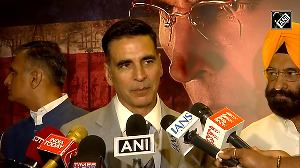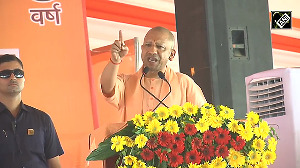ICICI Bank is a big money-center lender that deals with sizable companies in Bombay, Bangalore, and New Delhi. It is also one of India's biggest consumer lenders. So why does Nachiket Mor spend a lot of time in India's economically depressed rural hinterland looking for prospective borrowers?
He recently visited a family of five living in a soot-covered hut, getting by at barely subsistence levels in the North Indian state of Uttar Pradesh.
Mor signed off on a one-year, $130 loan that will allow the family to buy a buffalo and sell its milk. And written into this loan contract is a most unusual clause. If the animal isn't milking, the family gets a moratorium on its monthly loan repayment.
"The client would need to find other money to service the loan or even sell the buffalo to pay us, which would be counterproductive for both of us," explains Mor, deputy managing director at ICICI.
These kind of small IOUs are showing up more and more on the loan books of major Indian banks.
The microfinance movement -- lending as much as a few hundred dollars to poor entrepreneurs to set up businesses such as a small grocery store, family farm, or tailoring shop -- has been around for decades.
Back in the late 1970s, microfinance specialist Grameen Bank in Bangladesh pioneered the idea that the impoverished have skills that are underutilized, are surprisingly low credit risks, and should be given a chance.
In on the game
What's new is that India's biggest commercial lenders, such as HDFC and UTI banks, as well as the State Bank of India, have started to focus in on this sector in a serious way.
Even multinational banks with operations in India like ABN Amro, Standard Chartered, HSBC, and Citigroup are moving into the microfinance sector.
They are striking up partnerships with other microlending specialists in India, and there is even talk of creating a secondary market for these loans. Microloans could be bundled together into larger bond issues and sold to Indian and global investors. If that happens, it could create the kind of liquidity that might take microlending in India into a higher realm.
Helping themselves
The social need is definitely there. Despite India's spectacular growth this decade -- its economy has clocked 8%-plus growth over the past three years -- roughly 30% of India's 1 billion-plus population lives below the poverty line.
That's a huge market, and these bigger banks are discovering that lending small amounts to credit-worthy rural borrowers is lucrative as well as socially progressive. "Even as it is part of our sustainable development agenda, the trigger has been the large number of poor people residing in India," says Moumita Sen Sarma, head of microfinance at ABN Amro Bank.
Ranjan Ghosh, who heads financial institutions for India and South Asia at Standard Chartered Bank, adds: "With fewer defaulters in this sector, clearly the risk return rate is acceptable to banks. We look at it as investment."
Room for abuse
While this may sound like a nice intersection of corporate interests and social need, there are complications. For one thing, there have been allegations that some microlenders structure complicated loans with hidden costs to exploit borrowers.
The well-publicized suicides of about a dozen women caught in a debt trap in Andhra Pradesh over the last year cast industry practices in an unflattering light. Government inspectors accused four microlenders -- Spandana, Asmita, Umdama Pottu Pedatha, and Share Microfin -- of charging interest rates as high as 40% to 50% and harassing borrowers for repayment.
The microfinance lenders have since been lending at interest rates of around 24%.
The potential for abuse is always out there, but so is the potential for a huge expansion in lending to the underprivileged in India. Since 2003, ICICI has doubled the size of its rural banking activities to about $3.44 billion and has outstanding microloans of some $538
Fivefold growth
It has set up more than 100 tie-ups with small-town lending specialists and has about 3.2 million low-income customers. HDFC hopes to follow suit. Earlier this year, it created a microfinance unit with more than 100 employees and aims to double its lending levels in rural India to $22 million.
ABN Amro began microfinance operations in September, 2003, and has 24 Indian microfinance partners and $23 million in outstanding loans to this sector. Sarma predicts the bank's lending to this sector will grow fivefold by the end of the decade. It has already surpassed the bank's microcredit operations in Brazil, which began four years ago.
Vijay Mahajan, who runs a leading microfinance lender called Basix in the southern state of Hyderabad, thinks there is a $30 billion market for this kind of lending. There are about 350 million Indians living in poverty conditions, and more than 100 million households have no access to credit.
'Safer assets'
For well-managed lenders with the right kind of credit-risk controls, there is a vast market for loans in the $40 to $200 range. And big banks want to supplant neighborhood money lenders who currently meet about 80% of that demand.
"They have realized that the Indian poor are bankable," says Vikram Akula, head of SKS, a leading microfinance lender. The Reserve Bank of India wants the nation's major banks and foreign lenders operating in India to complement the small-scale lending for small agricultural and business loans.
It is also good business for Indian banks, given the diminishing market for lending to companies and consumers in major cities. "With cutthroat competition in the urban market where basic credit is reaching a saturation point, banks are going into villages to seek safer assets," says Keya Sarkar, a board member of several microfinance companies.
Local contacts
Still, setting up an extensive rural base of branches is costly, so major banks are looking for tie-ups with established microlenders, who know local markets better and have grown increasingly sophisticated. "What's also helped is the maturing of the intermediaries in India's decade-old microfinance industry," says Mahajan of Basix.
Typically, Indian banks have borrowed a page from Grameen Bank in Bangladesh by lending money to local microfinance firms that have contacts in small villages. They can identify worthy borrowers, which in many cases, means small enterprises run by women.
Some 30 million women have formed 2.2 million small businesses and another 400,000 are expected to be in place by March, 2007, according to the National Bank of Agriculture and Rural Development. About $2.48 billion has been extended to these groups, which predominantly run by women, over the last decade.
More products
Many lenders are also customizing their loans to reach out to more customers. That's the reason for ICICI Bank's $130 loan to that family in Uttar Pradesh. ICICI is also giving slightly larger loans to help families put their children through college. "There's a concern that's emerging that the standardized cookie-cutter approach that we had taken might not be suitable for all customers, hence the need to incorporate flexibility in loan-product design," says ICICI's Mor.
Other products for the rural population are being rolled out, such as savings plans, insurance, and even mutual funds. For instance, UTI Mutual Fund has tied up with Bank of India to sell its array of mutual fund products through the bank's rural network. Add it all up, and microfinance seems to have a very robust future in India.
Right now at least, small will continue to be beautiful for Indian banks that can get this market right.






 © 2025
© 2025